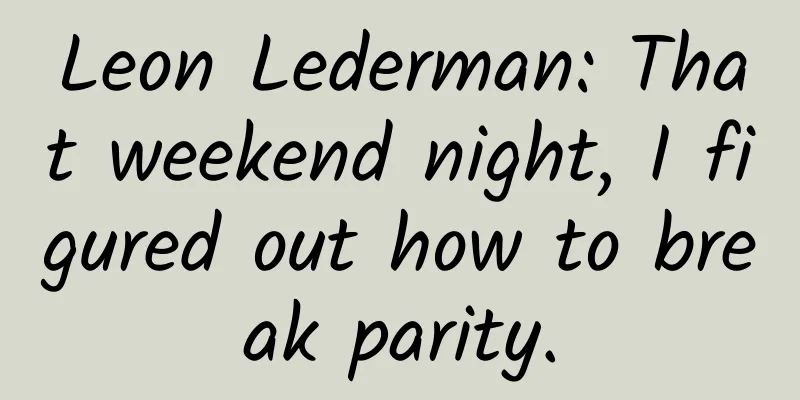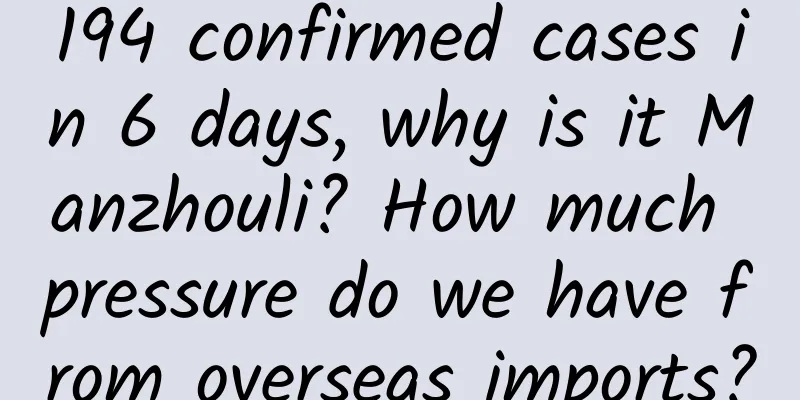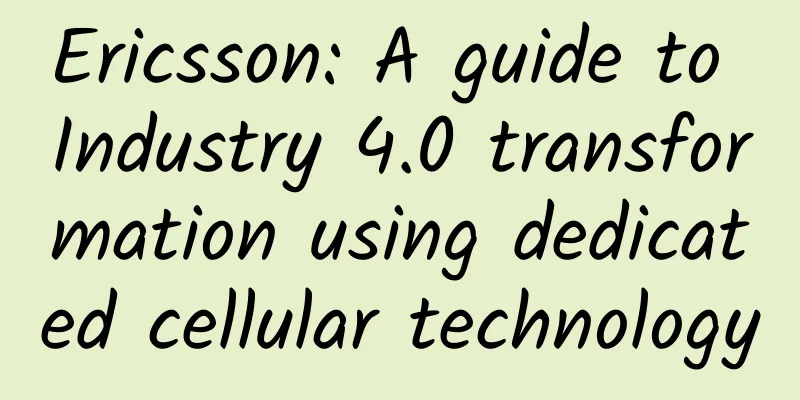Leon Lederman: That weekend night, I figured out how to break parity.

|
On January 4, 1957, at a traditional Chinese lunch gathering at the Columbia Physics Department, Lederman heard from Tsung-Dao Lee that Wu's ongoing parity experiment had achieved initial results. He wanted to verify the conservation of parity in another way - observing the decay of spin particles pions and muons, which was one of the experimental ideas proposed in Lee and Yang's 1956 paper. That night, Lederman conceived the experimental plan. If successful, they would see a "huge effect." In the book *The God Particle: If the Universe Is the Answer, What Is the Question?*, Lederman reviewed this experience in detail. The ending of the story is that Lederman and his colleagues witnessed "God's destruction" within four days and waited for Wu to verify the results before publishing a paper together. This article only introduces how Lederman thought of turning a series of miracles in the experiment into reality while driving. This article is authorized to be excerpted from the section "Interlude C: How we destroyed parity and discovered God in one weekend" in "The God Particle: An Interesting History of Particle Physics Written by a Nobel Prize Winner for Everyone" (Sichuan Science and Technology Press, 2022.6). It has been edited and the title is added by the editor. By Leon M. Lederman and Dick Teresi Translations: Mi Xujun, Gu Hongwei, Zhao Jianhui, Chen Hongwei Proofreader | Yin Chuanhong I can't believe that God is a weak left-handed person. ——Pauli The test of scientific objectivity is not to let enthusiasm interfere with methodology and self-critical spirit. —Leon Lederman Shanghai Restaurant It was Friday again. The time was frozen at 12 noon on January 4, 1957. Friday was the traditional Chinese lunch day for the faculty and staff of the Department of Physics at Columbia University. 10 to 15 physicists first gathered outside Professor Tsung-Dao Lee's office, and then walked together from the Pupin Physics Building on 120th Street to the Shanghai Restaurant at the intersection of 125th Street and Broadway. The lunch gathering began in 1953, when Tsung-Dao Lee had just received his doctorate and came to Columbia University from the University of Chicago. At that time, he had already gained a very high reputation as a theoretical superstar. Friday lunch was a noisy affair, with people chatting in groups, enjoying winter melon soup, tasting dragon and phoenix, shrimp balls, sea cucumbers, or other spicy northern Chinese dishes that were not very popular in 1957. On the way there, we knew the theme of this Friday's conversation: the latest news from Parity and our Columbia University colleague Chien-Shiung Wu, who was directing an experiment at the National Bureau of Standards in Washington. Before the luncheon began to discuss serious topics, Lee ordered his meals on a small pad handed to him by a respectful restaurant steward - a chore he had to do every week when he came to dine. Lee ordered his meals with style, an art. He glanced at the menu, the pad, asked the waiter a question in Chinese, frowned, and then picked up a pen and ran it across the paper, carefully writing a few symbols. Then another question, and made a change to a symbol. For divine guidance, he glanced at the embossed tin ceiling, and then, with a stroke of his pen, he wrote. The last time he looked, both of his hands were on the pad, one hand with five fingers extended, conveying the Pope's blessing to the crowd, and the other hand holding the pencil. Everything is here? The perfect blend of yin and yang, color, smell and taste? After handing the pad and pen to the waiter, Lee joined the conversation. "Ms. Wu called me and told me that her preliminary data showed an amazing effect!" he said excitedly. Let's go back to the laboratory with a mirror on one wall (the real world God created). Our general experience is that no matter what we hold up to the mirror, no matter what kind of experiment we do in the laboratory - scattering, making particles, gravity experiments like Galileo did, and so on - everything in the mirror laboratory obeys the same physical laws that govern the real world. Let's first look at how violations of parity conservation manifest themselves. To make the simplest objective test of chirality, let's take a resident of the planet "Twilo" and ask him to use a right-handed screw. Now, he faces the end with the hole in the hole and turns the screw clockwise. If the screw goes into a piece of wood, it is defined as a right-handed screw. Obviously, the mirror shows a left-handed screw, because the resident of "Twilo" in the mirror is turning the screw counterclockwise, and the screw goes in. OK, now suppose we live in an incredible world (such as the fantasy planet in "Star Trek"). It is impossible to use a left-handed screw here - it is completely contrary to the laws of physics. In this way, mirror symmetry will be destroyed; the mirror image of the right-handed screw will not exist, and parity conservation will be violated. That was the prelude. Tsung-Dao Lee and his colleague Chen-Ning Yang at the Institute for Advanced Study in Princeton suggested testing the validity of the laws of physics in the weak interaction. We need the equivalent of a right-handed (or left-handed) particle. Like a machine screw, we need to combine rotation with the direction of motion. Consider a spinning particle, the muon, and think of it as a cylinder spinning around its central axis, which gives us rotation. Because the two ends of the muon cylinder are exactly the same, we can't say whether it spins clockwise or counterclockwise. To see this, put it between you and your favorite rival. While you swear it's spinning to the right (clockwise), he insists it's spinning to the left. There's no way to argue who's right. This is a case of conservation of parity. The genius of Lee and Yang was to introduce the weak interaction (which they wanted to test) by observing the decay of spinning particles. One decay product of the muon is the electron. Suppose nature has dictated that the electrons should only come out of one end of the cylinder, which gives a direction; and we can also define the concept of spin - whether it is clockwise or counterclockwise - because one end is defined (the direction the electron came out of). This end acts as the tip of the screw. If the muon spins to the right (clockwise) relative to the electron it just decayed from, like the rotation of a machine screw relative to the tip of the screw, then we have defined a right-handed muon. Now, if these particles always decay in the defined right-handed way, then we have a particle process that violates mirror symmetry. This is what we see when the spin axis of the muon is parallel to the mirror, and the mirror looks like a left-handed muon - but it does not exist (see the figure below). Mirror Experiment and Parity Conservation Although word of Chien-Shiung Wu's situation had spread around the Christmas break, the Friday after New Year's was the first gathering of the Physics Department after the break. In 1957, Chien-Shiung Wu was a professor of physics at Columbia University, like me. She was an accomplished experimental scientist. Her research expertise was in the radioactive decay of atomic nuclei. She was extremely energetic and very demanding of her students and postdocs. She was also very careful and conscientious in analyzing experimental results, and the experimental data she published were widely praised for their high accuracy. In the summer of 1956, when T.D. Lee and C.N. Yang challenged the validity of the conservation of parity, Wu almost immediately set out to verify it. She chose the nucleus of the unstable radioactive atom cobalt-60 as her experimental subject. The nucleus of cobalt-60 spontaneously decays into a nickel nucleus, a neutrino, and a positively charged electron (positron). What we can "see" is that the cobalt nucleus suddenly emits a positron. This form of radiation is called beta decay, because the electrons emitted in this process, whether positive or negative, are initially called beta particles. Why does this phenomenon occur? Physicists call it the weak interaction, and believe that there is a force acting in nature that can cause such reactions. Forces are not just pushes and pulls, attractions and repulsions, but can also cause changes in the nature of matter, such as the process in which cobalt turns into nickel and emits leptons. Since the 1930s, a large number of reactions have been attributed to the weak interaction. The great Italian-American scientist Fermi was the first to give a mathematical form to the weak interaction, which allowed him to predict many details of reactions like the one that occurred in cobalt-60. In their 1956 paper, “Questions about the Conservation of Parity in the Weak Force,” Tsung-Dao Lee and Chen-Ning Yang selected a series of reactions and examined experimental evidence that parity — mirror symmetry — was not supported by the weak interaction. They were interested in the direction of the electrons emitted from the spinning nucleus. If the electrons preferred one direction over another, it would be like putting a button-down shirt on the cobalt nucleus. That way, we could tell which was the real experiment and which was the mirror image. What is the difference between ordinary scientific work and great ideas? Similar questions can be asked of a poem, a painting, a piece of music—indeed, even legal complaints can be very different. A work of art is left to time to be judged; in science, the truth or falsehood of an idea is determined by experiment. If it is a brilliant idea, it will often open up a new field of research, give rise to a host of new problems, and solve a host of old ones. Lee’s thinking was meticulous, and whether he was ordering food at lunch, commenting on some ancient Chinese porcelain, or evaluating a student’s ability, his opinions were sharp and precise, like a master’s use of axe, and his accuracy was unerring. In the paper on parity by Lee and Chen Ning Yang (I don’t know Yang very well), that precious thought had many sharp points. They used the Chinese impetus to question a law of nature that was once thought to be unbreakable. Lee and Yang realized that all this huge amount of data that had led to the “perfectly constructed” law of parity had nothing to do with the natural phenomenon that causes radioactive decay, namely the weak interaction. This was another brilliant and sharp point: it made us understand for the first time that different forces in nature can have different conservation laws. Lee and Yang rolled up their sleeves and went to the battle, sweating and full of inspiration. They checked a large number of radioactive decay reactions that could be used to test mirror symmetry. In the paper, they also analyzed the possible reactions in great detail so that silent experimentalists could test whether mirror symmetry was valid. Wu Jianxiong designed one of the experiments, and she used a cobalt reaction. The key to her method was to ensure that the cobalt nuclei - even if only a small part of the cobalt nuclei - could spin in the same way. Wu Jianxiong proposed that to ensure this, the cobalt-60 source could be operated at extremely low temperatures. Her experiment was extremely delicate and required the use of cryogenic equipment that was difficult to find. For this, she turned to the National Bureau of Standards, which had very advanced spin regulation technology. The penultimate dish at the banquet that Friday was a large carp stewed in black bean soy sauce with onions and leeks. While serving this dish, Lee repeatedly emphasized this key message: the effect discovered by Wu Jianxiong is very significant, more than 10 times what we expected. Although the data has not yet been seen, it is tentative and still very preliminary, but (Lee picked up the fish head for me, he knew I liked it) if the effect is indeed very significant, as we expected, if neutrinos are two components... I was distracted while listening, and I didn't know what he was saying next, because a new idea gradually emerged in my mind. Huge effect After lunch there was a symposium, some departmental meetings, a social tea party, and an academic seminar. I was distracted by all of these activities, thinking about Wu Jianxiong observing a "huge effect". Tsung-Dao Lee's talk at Brookhaven in August reminded me of the idea that parity would be lost in the decay of pions and muons. We ignored it for a while. A huge effect? In August I had taken a cursory look at the π-μ decay chain and realized that a reasonable experiment should be designed to have parity violation in two consecutive reactions. I kept thinking back to the calculations we did in August. However, if the effect is very large... Around 6 p.m., I drove north to my home in Dobbs Ferry for dinner and then, in the still evening, headed to Nevis Laboratory in Irvington-on-Hudson to swap shifts with my graduate students. The 400-megavolt accelerator at Nevis Laboratory was the workhorse for generating and studying muons, which were fairly new particles in the 1950s. In those happy days, there were only a few kinds of muons to care about, and Nevis focused on pions and muons. At Nevis Laboratory, we have a very intense stream of pions coming from a target being bombarded with protons. The pions are not stable, and as they fly out of the target, out of the accelerator, through the shielding wall, and into the experimental hall, about 20% of them undergo a weak decay into a muon and a neutrino. π→μ+ν (during flight) Muons usually fly in the same direction as pions. If the parity law is overturned, the number of muons whose spin axis is in the same direction as their motion will be greater than the number of muons whose spin axis points in the opposite direction of their flight. If the effect is huge, nature may provide us with an example of particles that all spin in the same way. This is what happened when Wu Jianxiong froze cobalt 60 in a magnetic field at very low temperatures. The key is to observe that a muon with a known spin axis decays into an electron and some neutrinos. Inspiration is born on the way On Friday night, I drove north on the Sawmill River Parkway. The road was very busy and I could vaguely see the beautiful hills covered with forests along the way. This road twists and turns along the Hudson River, passing through Riverdale and Yonkers and heading straight north. On the way, I thought about the possible "huge effect" and felt a sudden sense of enlightenment from time to time. For spinning matter, if any one direction of the spin axis dominates in particle decay, this effect will appear. A subtle effect might be that 1030 electrons are ejected in one direction relative to the spin axis, and 970 in the other direction, which is hard to draw conclusions about. But a large effect is, say, 1500:500, which makes the situation much simpler. This lucky large effect will also help arrange the spins of the muons. To do this experiment, we need instances where all the muons are spinning in one direction. Since the particles are traveling from the cyclotron to our device, the direction of the muon's movement can be used as a reference for the muon's spin. We need most of the muons to be right-handed (or all left-handed, it doesn't matter), and think of the direction of movement as a "thumb" for now. The muons will fly out, pass through several counters, and finally come to rest in a carbon block. Then we count how many electrons appear in the direction of the muon's movement and how many appear in the opposite direction. The huge difference in the number will be evidence of parity violation. Then we will be famous and lucky! Suddenly, an idea disrupted this ordinary, peaceful Friday night. I thought, we can easily do this experiment. My graduate student Marcel Weinrich has been doing an experiment involving muons. His experimental equipment can be slightly modified to look for the huge effect. At this time, I reviewed the method of producing muons using the accelerator at Columbia University. As an expert in this field, I had designed exotic muon and pion beams with Dingluo many years ago when I was still a reckless graduate student and the equipment was brand new. I pictured the whole thing in my mind: an accelerator with a 4,000-ton magnet, a circular pole about 20 feet in diameter, and a huge stainless steel box emptied of air, the vacuum chamber, inside the accelerator. A stream of protons, fed by tiny pipes, enters the center of the magnet. The protons are repeatedly sprinted and spiraled under strong radio frequency voltages. When the particles reach the end of their spiral journey, they have an energy of 400 mega-electron volts. Near the edge of the vacuum chamber, where our magnets are basically out of reach, a small rod carrying a graphite sheet waits to be bombarded by the high-energy protons. Their 400 million volts are enough to cause these high-energy protons to produce new particles, pions, when they collide with carbon nuclei in the graphite target. I was watching the pions as they were ejected by the protons. They were born between the poles of the cyclotron's powerful magnets and flew out in a gentle curve, disappearing outside the cyclotron. There they were followed by muons, who continued their journey. The rapidly disappearing magnetic field outside the pole pieces led the muons down a tunnel through the 10-foot-thick concrete protective wall and into the experimental hall, where we had been waiting for them. In the lab, Marcel is starting up the equipment. The muons will slowly fall into a 3-inch thick filter and then be sent to a 1-inch thick material containing various elements for temporary storage. The muons will gently collide with the atoms in the material, losing energy, and will eventually be captured by the positively charged nuclei due to their negative charge. Since we don't want anything to affect the direction of the muon's spin, and being captured into orbit would be destructive, we have to use positively charged muons. What will a positively charged muon do? Probably just spin there quietly until it decays. The material must be carefully selected, and carbon seems to be a good choice. Now, a key idea occurred to me as I drove northbound on a Friday in January. If all (or nearly all) of the muons produced when the pions decayed could somehow adjust their spins to point in the same direction, then that meant that the pion-to-muon reaction violated parity conservation, and violated it badly. A huge effect! Now suppose that as the muons flew out of the machine in a graceful arc through the tunnel, their spin axes remained parallel to their direction of motion (which is what would happen if the g factor was close to 2); and further suppose that the countless gentle collisions with carbon atoms slowed the muons down without changing the relationship between spin and direction of motion. If that were true, it would be bizarre! I would have a scheme for getting the muons into a block of material to hold them, spinning in the same direction. It seems that a successful experiment requires a series of miracles. Indeed, when Tsung-Dao Lee and Chen-Ning Yang published their paper in August, the need for such a series of miracles frustrates us. One small effect can be conquered with patience, but two small effects in a row—one hundredth of one percent—can make the experiment hopeless. Why two small effects in a row? Recall that nature must provide pions that decay into muons with roughly the same spin direction (miracle one); muons must also decay into electrons whose spin axis is clearly asymmetric with respect to the muon (miracle two). I became very excited when I passed the Yonkers toll booth (which charged 5 cents in 1957). I was really sure that if parity violation was significant, then the muons were polarized (the spin axes pointed in the same direction). I also figured out that the magnetic properties of the muon spins were due to the magnetic field "switching" the spin directions in the direction of the particle's motion. As for what would happen to the muons when they entered the energy-absorbing graphite, I was not very sure. If I was wrong, the spin axes of the muons would be all over the place. In that case, it would be impossible to observe the emission of electrons relative to the spin axis. Let's review this. The decay of the pions produces muons whose spins are in the same direction as their motion, which is part of the miracle. Now I should stop the muons so that I can see the direction of the electrons they emit when they decay. Since we know the direction they were moving before they hit the carbon, we will know the direction of their spins when they stop and decay, assuming nothing is rotating them. What we need to do now is to rotate our electron detection arm around the carbon, where the muons are waiting to be checked for mirror symmetry. My palms began to sweat as I rethought what I was going to do. The counters were all there. The electronics that told us when the high-energy muons arrived and slowly entered the graphite block were now in place and tested, as were the four counters that would detect the electrons produced by the decay of the muons. All we had to do was fix these things in a certain way on a board and mount it around the center of the graphite block. Only an hour or two of work. Oh! But I felt like we were in for another sleepless night! Special Tips 1. Go to the "Featured Column" at the bottom of the menu of the "Fanpu" WeChat public account to read a series of popular science articles on different topics. 2. Fanpu provides a function to search articles by month. Follow the official account and reply with the four-digit year + month, such as "1903", to get the article index for March 2019, and so on. Copyright statement: Personal forwarding is welcome. Any form of media or organization is not allowed to reprint or excerpt without authorization. For reprint authorization, please contact the backstage of the "Fanpu" WeChat public account. |
<<: Does snoring mean you are sleeping well? In fact, it is the enemy of your health.
>>: Be careful of breaking the law! What you bought may be a national second-level protected plant
Recommend
Taxi creative advertising slogan
So how do you write a taxi advertisement ? Becaus...
How did a good lion specimen become an Internet celebrity?
In the Shanghai Natural History Museum, you can s...
Why are there so many strong earthquakes in Xinjiang? Will there be strong aftershocks? Expert analysis
According to the official measurement of the Chin...
Say goodbye to iOS and common off-screen rendering!
The optimization of mobile applications mainly de...
JAVA medical construction project high-end project practice
Introduction to practical resources for high-end ...
Google open-sources new font Roboto-serif, a variant of the Android system font
On February 16, Google launched a new open source...
How do K12 education and training institutions use "Double 12" to carry out promotional activities?
For educational institutions, there are relativel...
Brand Marketing: How to build a brand?
Let’s answer a question first: what is a brand? W...
Yiche.com: In June 2024, the Wenjie M9 won the first place in weekly sales of domestic cars with more than 400,000 units, twice as much as Ideal L9
Recently, Yiche.com released a weekly sales ranki...
What exactly does community operation do?
Community operation has always been a difficult p...
Adding “5G” after the Wi-Fi name will make the Internet faster?
When connecting to Wi-Fi, many netizens may find ...
A "senior stylist" who can "play" with proteins? Generative AI designs a new antibody for the first time!
The field of protein design has reached another m...
The stomach is most afraid of these "several things". One more thing will bring you closer to gastric cancer! Doctors: Many people are diagnosed at the late stage
Expert of this article: Hu Zhongdong, chief physi...
After another year of tinkering, what is the dilemma facing WeChat Mini Programs?
WeChat Mini Programs have launched games, but a y...
How to create a “hit product”?
Introduction: As long as the trend is right, ever...









